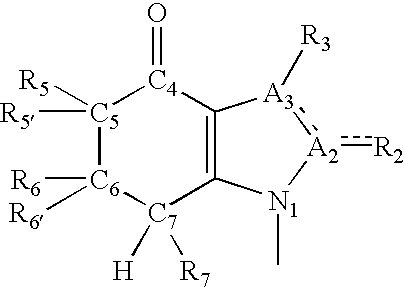Synthesis and methods of use of tetrahydroindolone analogues and derivatives
a technology of tetrahydroindolone and derivatives, which is applied in the field of bifunctional conjugates, can solve the problems of inability to achieve effective treatment, inability to prepare compounds that incorporate tetrahydroindolone or its analogues, and inability to achieve nootropic activity or neuroproliferative activity, so as to stimulate the growth of neurons and increase the level of mrna encoding
- Summary
- Abstract
- Description
- Claims
- Application Information
AI Technical Summary
Benefits of technology
Problems solved by technology
Method used
Image
Examples
example 2
Passive Avoidance Method of Testing Compounds
Passive avoidance is an acute memory paradigm that indicates an increased nueonal function. In this paradigm mice are allowed to enter a dark compartment from a lighted compartment, but are given a footshock (2 mA for 5 seconds) when they enter the dark compartment. Twenty-four hours after this training session, animals that are placed back in the lighted compartment of two compartment (light-dark) apparatus do not make the transition into the dark compartment. If an amnestic agent (30 mg / kg cycloheximide i.p. in saline) immediately after the training session is given to the animals, they will make the transition into the dark compartment (i.e. memory of the shock is lost). Compounds with suspected nootropic or anti-amnestic effects are given by i.p. administration two hours prior to the training trial in attempt to block the effects of cycloheximide. Mice that exhibit positive nootropic effects are those that avoid moving into the dark c...
example 3
Passive Avoidance Test of 4-[3-(4-Oxo-4,5,6,7-tetrahydroindolon-1-yl)propionylamino}Benzoic Acid Ethyl Ester (Example 1) Administered Intraperitoneally
The passive avoidance test of Example 2 was used to test 4-[3-(4-oxo-4,5,6,7-tetrahydroindolon-1-yl)propionylamino}benzoic acid ethyl ester (Example 1) with intraperitoneal administration with doses ranging from 0.00001 to 10 mg / kg. The minimum effective dose (MED) is 0.001 mg / kg.
Advantages of the Present Invention
The present invention provides tetrahydroindolone analogues and derivatives that exert a number of biological and physiological functions, particularly increased neuronal function that may involve nerve regeneration in the peripheral nervous system, neurogenesis in the central nervous system, and neuroprotection. The tetrahydroindolone analogues and derivatives of the present invention are capable of passing through the blood-brain barrier and exerting their effects in the central nervous system. The components of the tetrah...
PUM
| Property | Measurement | Unit |
|---|---|---|
| logP | aaaaa | aaaaa |
| weight | aaaaa | aaaaa |
| structure | aaaaa | aaaaa |
Abstract
Description
Claims
Application Information
 Login to View More
Login to View More - R&D
- Intellectual Property
- Life Sciences
- Materials
- Tech Scout
- Unparalleled Data Quality
- Higher Quality Content
- 60% Fewer Hallucinations
Browse by: Latest US Patents, China's latest patents, Technical Efficacy Thesaurus, Application Domain, Technology Topic, Popular Technical Reports.
© 2025 PatSnap. All rights reserved.Legal|Privacy policy|Modern Slavery Act Transparency Statement|Sitemap|About US| Contact US: help@patsnap.com



